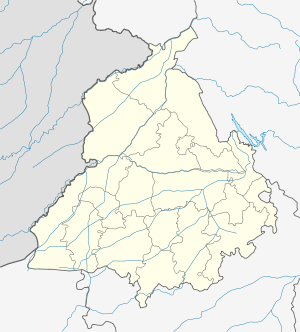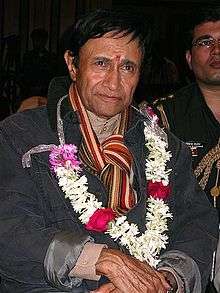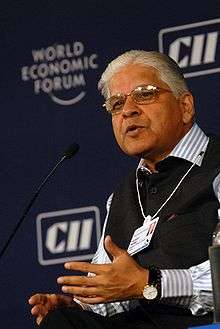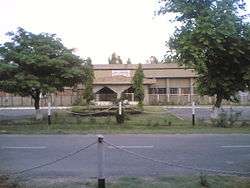Gurdaspur
| Gurdaspur ਗੁਰਦਾਸਪੁਰ | |
|---|---|
| City | |
|
Mechanical Block | |
 Gurdaspur  Gurdaspur | |
| Coordinates: 32°02′00″N 75°24′00″E / 32.0333°N 75.40°ECoordinates: 32°02′00″N 75°24′00″E / 32.0333°N 75.40°E | |
| Country | India |
| State | Punjab |
| District | Gurdaspur |
| Area | |
| • Total | 10 km2 (4 sq mi) |
| Elevation | 241 m (791 ft) |
| Population (2011) | |
| • Total | 75,549 |
| • Density | 649/km2 (1,680/sq mi) |
| Languages | |
| • Official | Punjabi |
| Time zone | IST (UTC+5:30) |
| PIN | 143521 |
| Vehicle registration | PB 06 |
| Website |
gurdaspur |
Gurdaspur (Punjabi: ਗੁਰਦਾਸਪੁਰ) is a city in the state of Punjab, situated in the northwest part of the Republic of India, between the rivers Beas and Raavi, 10 km from the international border between India and Pakistan. It houses the administrative headquarters of Gurdaspur District and is in the geographical centre of the district, being situated on the Amritsar – Jammu National Highway, 36 km from Pathankot and 32 km from Batala. Head offices of all district departments are located in Batala and Gurdaspur.
Gurdaspur city was named after Mahant Guriya das ji.[1] The Emperor Akbar was crowned at Kalanaur, which is 26 km from the city. Behrampur town, where the Maqbara (mausoleum) of Bairam Khan is situated, is 10 km away. Dinanagar town, which was the capital of the kingdom of Maharaja Ranjit Singh, is 12 km away. The well-known woolen mill located in Dhariwal, is also 12 km from the city.
Demographics
According to the 2011 India census,[2] Gurdaspur had a population of 2,299,026 (1,212,995 males and 1,086,031 females). There was a 9.30% increase in population compared to that of 2001. In the previous 2001 census of India, Gurdaspur District had recorded a 19.74% increase to its population compared to 1991.
The average literacy rate of Gurdaspur in 2011 was 81.10%, compared to 73.80% in 2001. The male and female literacy rates were 85.90% and 75.70%, respectively. For the 2001 census, the rates were 79.80% and 67.10% respectively. The total literate population was 1,668,339, consisting of 928,264 males and 740,075 females. Sex ratio is about 895 females per 1000 males. Population Density was 649 per square km. [2]
History

Obv: Standing figure, probably of Vishvamitra, Kharoshthi legend, around: Mahadevasa Dharaghoshasa/Odumbarisa "Great Lord King Dharaghosha/Prince of Audumabara", across: Viçvamitra "Vishvamitra".
Rev: Trident battle-axe, tree with railing, Brahmi legend identical in content to the obverse.[3]
Gurdaspur, a major city of Punjab, was founded by Guriyaji Mahant in the 17th century. The place forms the northernmost part of the state. Resting within Jalandhar division, and flanked by the rivers Beas and Ravi, it shares its boundary with the districts of Hoshiarpur, Kapurthala, Amritsar and Pathankot.
Guriyaji laid the foundation of the city on land that he had bought from the Jats. Almost no evidence of the ancient history of the place is available, so not much is known about it. For a long period it was under the rule of the Shahi dynasty. A ruler named Jasrath Khokhar was defeated by Malik Sikander. With the fall of the Mughal Empire, the city came under the supremacy of the Sikh gurus. The place is linked to many eminent Sikh Gurus including Guru Gobind Singh, Guru Hargobind and Guru Nanak Dev. Maharaja Ranjit Singh made it one of his strongholds. After partition, a major portion of the city was ceded to India.
Seven kilometres to the west of the city, is Gurdas Nangal, a holy place linked to the heroic battle of Banda Bahadur with the Mughal armies . A gurudwara, a place of worship, whose entrance has an inscription describing the famous battle, is located here. It lies 10 kilometres from the city and was the site of a great massacre of Sikhs in 1746.
During the Misl period, Gurdaspur remained the centre of activity of Kanheya Misl and Ramgharia Misl. Maharaja Ranjit Singh conquered Ramgharia Misl in 1808, and Kanheya Misl in 1811, so they became a part of Maharaja Ranjit Singh’s empire.
The British East India Company annexed Punjab on 29 March 1849, after the second Anglo-Sikh war of 1839-49. After annexation, a need arose for recognition of districts for administrative purpose. As a result, Gurdaspur district was formed on 1 May 1852. The district of Adinanagar was renamed to Gurdaspur. So, from a tiny village, Gurdaspur became a district headquarters.
The mutiny of 1857 also affected Gurdaspur. The mutineers from Sialkot proceeded towards Gurdaspur. The British forces intercepted these mutineers at Trimmo Patan and defeated them in the battle of Trimmo Patan (12–16 July 1857). The prisoners were hanged in Bole Wala Bagh, situated behind Government College Gurdaspur.
Partition of 1947
During the partition of India in 1947, the future of Gurdaspur could not be decided for many days, as the majority of the population of this district, 51.14% was Muslim. The Radcliffe boundary awards transferred only Shakargarh Tehsil of the Gurdaspur district to Pakistan. The rest of the district was transferred to India against the agreement. The Muslim population of the district forced to migrate to Pakistan. Many refugees, the Hindus and the Sikhs of Sialkot and Tehsil Shakargarh, migrated to Gurdaspur after crossing the Ravi bridge. They settled and spread throughout Gurdaspur district. The transfer of Gurdaspur to India soon proved to be advantageous to India. It offered the only viable route to Kashmir for Indian army to take control of kashmir after partition ((cite)).
At the time of partition, Gurudwara Kartarpur Sahib, a famous Sikh heritage site went to Pakistan.
Transport
Rail
Gurdaspur railway station is connected with the nearest station Pathankot and Amritsar. From Gurdaspur there are many trains to Pathankot and Amritsar. There are two mail trains: Jammu Tawi (Jammu to Tata Nagar) and the Pathankot-Delhi express.
There is a daily train from Dera Baba Nanak to Amritsar.
Road
Gurdaspur is well connected to the road network National Highway 15 (NH 15). It is a major national highway in Western and Northwestern India. NH 15 connects Kandla in Gujarat with Gurdaspur in Punjab. This 1,526 km (948 mi)-long highway passes through: Gurdaspur, Amritsar, Tarn Taran Sahib, Zira, Kotkapura, Bhatinda, Ganganagar, Bikaner, Jaisalmer and Barmer. At Bikaner the National Highway 11 terminates at this highway.
With a total length of 1,526 km (948 mi), the NH15 traverses 350 km (220 mi) in Punjab, 906 km (563 mi) in Rajasthan, and 270 km (170 mi) in Gujarat. It also connected Gurdaspur to Jammu through bmial, Kathua, and with NH 1A through Gurdaspur, Mukerian and Gurdaspur Shri Hargobind State Highways.
Media
Gurdaspur has an All India Radio relay station known as Akashvani Gurdaspur. It broadcasts on FM frequencies.
Education
Gurdaspur has many elementary and secondary level schools and has 13 degree level and engineering colleges.[4] Beant College of Engineering & Technology Gurdaspur is among them, founded by then Chief Minister Beant Singh in 1995. A nationally accredited body by Ministry of Tourism (India) Institute of Hotel Management, Catering & Nutrition is also located in Gurdaspur.[4]
Notable People
- Abdul Aziz Wains, former sports shooter
- Premchand Degra, Mr. Universe, Mr. World, Mr. Asia(8 times), Mr. India (9 times in a row) internationally famous body builder

- Dev Anand,[5] famous Indian actor
- Gurbachan Singh Salaria S/O Chaudhary Munshi Ram Salaria (born 29 November 1935; Gurdaspur, Punjab – 1961) is a military war hero, who was awarded the Param Vir Chakra, India's highest wartime military award
- Naresh Trehan Sri hagobindpur near batala, famous Indian cardiologist and cardiothoracic surgeon
- Shiv Kumar Batalvi (Batala){the famous Punjabi writer}
- Nek Chand Saini, famous for building Rock Garden Chandigarh
- Bhagat Namdev, also transliterated as Namdeo and Namadeva, (traditionally, c. 1270 – c. 1350 CE) was a poet-saint who is significant to the Varkari sect of Hinduism.
- Gurpreet Ghuggi
- Ranjit Bawa
- Satinder Satti
- Preet Harpal
- Varinder Singh Ghuman
- Surjit Singh Randhawa, famous hockey player
- Principal Sujan Singh,(of Dera Baba Nanak), Father of Punjabi Short Story (Sahitya Akademy Award 1987 for book 'Shahar te Garan')
- Teja Singh, ( Village Munanawali)Freedom Fighter. Active in Gurdaspur Conspiracy Case against Britishers
- Air Chief Marshal Dilbagh Singh,[6] former chief of Indian Airforce
- Prabhjot Singh, Indian hockey player[7][8]
- Vijay Anand

- Ashwani Kumar, Leader
- Sobha Singh (painter)
- Teja Singh Akarpuri
- Jasbir Jassi, popular Bhangra singer
- Manpreet Gony, Cricket player
- Lt. Navdeep Singh, soldier who was posthumously awarded the Ashoka Chakra Award
- Partap Singh Bajwa President PPCC
- Baba Jaimal Singh ji,(1839–1903), popularly called "Baba Ji Maharaj"
.jpg)
- Pandit Lekh Ram was an arya samaji
.jpg)
- Mirza Tahir Ahmad, Khalifatul Massih IV of the Ahmadiyya Muslim Community, was born in Qadian
- Iqbal Bahu, Pakistani Sufi singer, born in Gurdaspur but migrated to Pakistan after Independence.
- Mirza Ghulam Ahmad (of Qadian), founder of the Ahmadiyya Movement in Islam
- Mirza Basheer-ud-Din Mahmood Ahmad, Khalifatul Massih II of the Ahmadiyya Muslim Community
- Ishfaq Ahmad, born in Gurdaspur, migrated to Pakistan
- Ghulam Ahmed Pervez, founded Tolu-e-Islam movement, migrated to Pakistan
- Alla Rakha, Tabla player.
- Zakir Hussain, Tabla player.
- Yo Yo Lucky Singh(Lucky Suryavanshi) (Vill. Malook Mattam,Block Dinanagar){the famous Sound Recordist,Suffi Singer,Music Arranger,Music Directer & Video Director}
- Chaudhry Niaz Ali Khan (of Jamalpur) founder of the Dar-ul-Islam Trust Institutes
- Om Parkash Chhabra ( city Gurdaspur ). Well known artist of Gurdaspur who was awarded many times for his art work by the Government of India. He painted historical monuments of Gurdaspur. His art work was given the name "Samarakaan Di Hook". He worked as art teacher at Little flower convent school Gurdaspur and Senior secondary school Sohal.
- Yo Yo Lucky Singh(Lucky Suryavanshi) (Vill. Malook Mattam,Block Dinanagar){the famous Sound Recordist,Suffi Singer,Music Arranger,Music Directer & Video Director}
References
- ↑ "About District". Gurdaspur.nic.in. Retrieved March 2013. Check date values in:
|access-date=(help) - 1 2 "Gurdaspur District Population Census 2011, Punjab literacy sex ratio and density". Census2011.co.in. Retrieved March 2013. Check date values in:
|access-date=(help) - 1 2 Ancient India, from the earliest times to the first century, A.D by Rapson, E. J. p.154
- 1 2 "Education Facilities in District Gurdaspur". Gurdaspur.nic.in. Retrieved March 2013. Check date values in:
|access-date=(help) - ↑ "Romancing With Life By Dev Anand | India Special". Indiaspecial.net. 24 February 2009. Retrieved March 2013. Check date values in:
|access-date=(help) - ↑ "The Tribune, Chandigarh, India - Nation". Tribuneindia.com. Retrieved March 2013. Check date values in:
|access-date=(help) - ↑ "Hockey Olympian Prabhjot Singh to marry on Feb 20". Zeenews.com. 18 February 2009. Retrieved March 2013. Check date values in:
|access-date=(help) - ↑ "Prabhjot Singh Biography, Prabhjot Singh Bio, Prabhjot Singh Photos, Videos, Wallpapers, News". Connect.in.com. Retrieved March 2013. Check date values in:
|access-date=(help)
Further reading
- Chester, Lucy P. Borders and Conflict in South Asia: The Radcliffe Boundary Commission and the Partition of Punjab. Manchester UP, 2009.
-
 Chisholm, Hugh, ed. (1911). "Gurdaspur". Encyclopædia Britannica. 12 (11th ed.). Cambridge University Press.
Chisholm, Hugh, ed. (1911). "Gurdaspur". Encyclopædia Britannica. 12 (11th ed.). Cambridge University Press. - Official website
